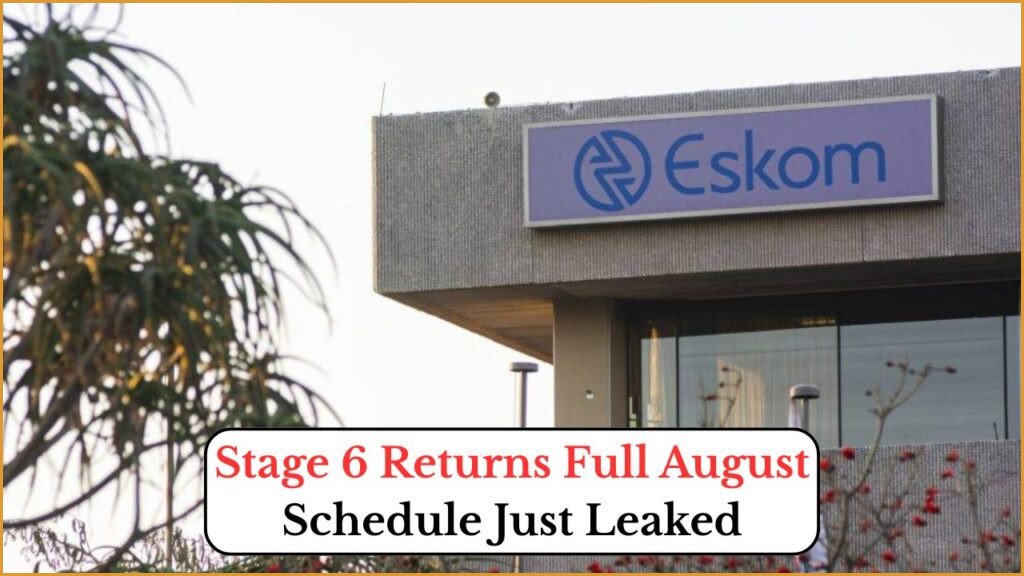Eskom’s August 2025 Stage 6 Load Shedding: As South Africa prepares for another challenging phase of power management, Eskom has announced the implementation of Stage 6 load shedding in August 2025. This development means that citizens should brace themselves for up to 10 hours of daily power cuts, significantly impacting daily routines and business operations. Load shedding in South Africa is a common occurrence, but Stage 6 indicates a more severe shortage, requiring strategic planning from both individuals and businesses to mitigate disruptions. As the country navigates these power challenges, understanding the implications and preparing accordingly will be crucial for maintaining productivity and daily life.

Understanding the Impact of Stage 6 Load Shedding in August 2025
Eskom’s recent announcement about Stage 6 load shedding in August 2025 has left many South Africans worried about the future. Stage 6 is not just a number; it signifies a severe electricity shortage where more energy needs to be shed from the grid to maintain stability. The implications of this are far-reaching, affecting everything from home life to national productivity. In practical terms, Stage 6 could result in prolonged power outages, sometimes spanning up to 10 hours a day. This can disrupt work-from-home arrangements, halt manufacturing processes, and strain essential services like hospitals and emergency response teams. It is vital for residents and businesses to prepare for these power cuts by investing in alternative energy sources, such as solar panels or generators, and implementing energy-saving measures to reduce dependency on the grid.
 Blocked NSFAS Allowance? Discover the Viral WhatsApp Hack Helping Students Reclaim Their Payments
Blocked NSFAS Allowance? Discover the Viral WhatsApp Hack Helping Students Reclaim Their Payments
- Prolonged power outages affecting daily life.
- Disruption to businesses and critical services.
- Increased reliance on alternative energy solutions.
- Potential financial impact on small enterprises.
- Necessity for strategic energy management.
- Impact on South Africa’s economic growth and development.
- Importance of government and private sector collaboration.
Preparing for Eskom’s Stage 6 Load Shedding in South Africa
Preparation is key to navigating the challenges posed by Eskom’s Stage 6 load shedding. South Africans must consider several strategies to minimize disruptions. For households, investing in rechargeable lights, power banks, and gas stoves can maintain a semblance of normalcy during power cuts. Businesses, especially small to medium enterprises, should consider acquiring backup generators or battery systems to ensure operations continue smoothly. Moreover, scheduling high-energy tasks during off-peak times when electricity is available can help manage energy consumption effectively. On a larger scale, companies and households alike should explore renewable energy options like solar power, which, although initially costly, can provide a reliable and sustainable energy source in the long run.
| Item | Investment Cost | Usage | Benefits | Challenges |
|---|---|---|---|---|
| Solar Panels | High | Long-term | Renewable energy, cost-saving | Initial setup cost |
| Generators | Medium | Short to medium-term | Immediate backup power | Fuel cost and maintenance |
| Rechargeable Lights | Low | Short-term | Immediate light availability | Limited duration |
| Power Banks | Low to Medium | Short-term | Portable power source | Limited capacity |
| Gas Stoves | Medium | Long-term | Cooking during outages | Fuel cost |
How Stage 6 Load Shedding Affects South Africa’s Economy
The economic impact of Stage 6 load shedding is a significant concern for South Africa. As businesses face operational difficulties due to intermittent power supply, productivity levels are expected to decline. This is particularly challenging for industries heavily reliant on continuous electricity, such as manufacturing and IT services. The ripple effects of power shortages also extend to small businesses, which may not afford the additional costs of backup power solutions. Furthermore, the uncertainty surrounding electricity availability could deter foreign investment, as investors seek more stable environments for their ventures. The government and private sector must collaborate to develop robust infrastructure and policies that prioritize sustainable energy solutions, ensuring long-term economic stability and growth.
Strategies for Mitigating Economic Impact
- Encouraging investment in renewable energy projects.
- Enhancing energy efficiency in industries.
- Developing policies for sustainable energy management.
- Supporting small businesses in acquiring backup power sources.
- Implementing educational programs on energy conservation.
- Creating incentives for businesses adopting green energy.
- Strengthening public-private partnerships in energy sectors.
Community Responses to Eskom’s Stage 6 Load Shedding Announcement
Communities across South Africa are responding to the Stage 6 load shedding announcement with a mix of resilience and frustration. Many are coming together to share resources and support one another during outages. For instance, community centers and public facilities are being used as charging stations or temporary workspaces for those without backup power at home. Social media platforms have become invaluable for sharing information on load shedding schedules and tips on energy conservation. Despite the challenges, there is a growing sense of solidarity among citizens, with local initiatives emerging to address energy needs creatively and sustainably.
- Establishing community charging stations.
- Utilizing social media for load shedding updates.
- Organizing neighborhood energy conservation workshops.
- Forming cooperative buying groups for alternative energy solutions.
- Engaging in collective advocacy for better energy policies.
- Sharing resources and knowledge locally.
- Encouraging local businesses to adopt green practices.
Exploring Alternative Energy Solutions for South Africa
As South Africa grapples with ongoing power challenges, exploring alternative energy solutions is becoming increasingly critical. Solar energy, wind power, and bioenergy are among the top contenders for addressing the country’s energy deficit. Solar energy is particularly promising due to South Africa’s abundant sunlight, making solar panels an efficient option for both urban and rural areas. Wind power is another viable solution, especially in coastal regions where wind speeds are optimal. Additionally, bioenergy, which utilizes organic materials, offers a renewable option that can contribute to a diversified energy mix. These solutions not only promise energy security but also align with global sustainability goals and help reduce carbon emissions.
Comparing Alternative Energy Options
- Solar Energy: High initial cost but long-term savings and sustainability.
- Wind Power: Requires specific geographic conditions; potential for large-scale application.
- Bioenergy: Utilizes waste materials; supports circular economy models.
- Hydropower: Limited by water availability; potential in specific regions.
- Geothermal: Geographically constrained; potential for localized applications.
FAQ: Navigating Eskom’s Stage 6 Load Shedding
What is Stage 6 load shedding?
Stage 6 load shedding involves significant power cuts, with up to 10 hours of outages daily, to prevent the national grid from collapsing.
How can households prepare for power cuts?
Households can prepare by investing in rechargeable lights, power banks, gas stoves, and considering solar energy solutions.
What impact does load shedding have on businesses?
Load shedding disrupts operations, particularly for industries reliant on consistent power, affecting productivity and financial performance.
Are there long-term solutions to Eskom’s load shedding?
Long-term solutions include investing in renewable energy infrastructure and enhancing energy efficiency across sectors.
How can communities cope with extended outages?
Communities can establish charging stations, share resources, and organize local initiatives to support each other during power cuts.
How can individuals prepare for 10-hour daily power cuts in August 2025?
Stock up on essentials, invest in backup power sources.
What impact does Stage 6 load shedding have on South Africa's economy?
It leads to disruptions, productivity losses, and potential economic downturn.
How does Eskom plan to address the challenges causing Stage 6 load shedding?
By implementing infrastructure upgrades and increasing power generation capacity.
What measures are in place to mitigate the effects of prolonged power cuts?
Implementing backup power sources and energy-saving practices can help alleviate disruptions.








